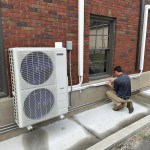Creating an environment of consistent comfort inside a home is not just about adjusting a thermostat—it’s about understanding the home’s unique personality. Every structure has quirks, insulation variables, and airflow tendencies, making a one-size-fits-all HVAC solution less effective. That’s where the approach of personalization makes a significant difference. Atticman Heating and Air Conditioning, Insulation has adopted a tailored approach that doesn’t just install systems—it adapts them to each home’s specific needs. We will explore how this tailored method transforms home comfort, reduces energy waste, and creates a more sustainable indoor climate.
Tailoring Temperature Control to Individual Structures
No two homes are alike, and heating and cooling systems should reflect that reality. A house’s size, shape, and orientation all influence how it gains or loses heat throughout the year. A south-facing living room in a single-story home in Sacramento behaves very differently from an upstairs bedroom in a two-story house in a shaded neighborhood. Factors like attic insulation, window quality, and air duct integrity all impact how efficiently a heating and cooling system performs. Regarding HVAC in Sacramento, climate sensitivity and home variation demand a tailored approach. Rather than relying on standard solutions, the team behind Atticman’s approach thoroughly assesses the property, identifying specific weak points that impact comfort.
For example, an older home may require targeted insulation improvements in the attic before installing a new air conditioning unit. A newer home might benefit more from air balancing to eliminate uneven room temperatures. These assessments ensure that the systems installed are functional and optimized for the environment they operate in. This attention to detail means homes maintain consistent temperatures, see fewer maintenance issues over time, and use less energy overall. The customized approach transforms the HVAC system from a generic fixture to an integrated part of the home’s living ecosystem.
Energy Efficiency Begins with the Structure Itself
A high-efficiency air conditioning or heating system is only as effective as the structure supporting it. The Atticman strategy focuses on the home’s envelope—the insulation, ductwork, and attic conditions determining how easily air moves and heat transfers. Ensuring that homes are well-insulated and air ducts are sealed properly reduces the overall workload on the heating and cooling system. This prolongs the system’s lifespan and slashes monthly energy bills. Homes with adequate attic insulation retain heat better in winter and stay cooler in summer without relying heavily on machinery.
The company ensures its customers get the full value of their system’s potential by upgrading insulation and improving ductwork before or during HVAC installations. This structural-first method avoids installing powerful systems that still struggle due to poor infrastructure. It’s a practical and economical way to deliver long-term value and climate control that feels effortless. It also leads to quieter systems and improved indoor air quality, as sealed ducts prevent dust and pollutants from infiltrating the home’s air supply. The result is a seamless blend of comfort, efficiency, and peace of mind, built on the foundation of the home itself.
Smart System Design Based on Daily Life Patterns
Heating and cooling needs don’t just come from a home’s size or age—they’re shaped by how people live. A household with young children may need cooler rooms during nap times, while a retired couple might prioritize evening comfort in specific areas of the home. Understanding these lifestyle patterns is essential for designing a system that truly supports how residents move through their day. The customized approach goes beyond mechanics to factor in human behavior, tailoring system controls, zone settings, and airflow patterns around the homeowner’s habits.
For example, multi-zone temperature systems allow homeowners to heat or cool only the parts of the house they use most, saving energy without sacrificing comfort. Programmable thermostats or smart systems can learn usage patterns and adapt accordingly, offering the convenience of automation with the precision of custom control. Rather than forcing users to adjust their routines to the limitations of their HVAC system, this method creates comfort zones that match the household’s rhythm. By integrating personalized design with smart technology, the result is energy-efficient, intuitive, responsive, and aligned with how life is lived inside the home.
Long-Term Value through Maintenance and Monitoring
Even the most well-installed HVAC system needs attention to perform consistently over the years. One of the hallmarks of a tailored approach is that the care doesn’t stop after installation. Regular maintenance and performance evaluations help homeowners stay ahead of wear and tear, preventing small issues from escalating into major repairs. By scheduling check-ups based on each system’s unique demands and the home’s specific conditions, the service remains relevant long after the installation is complete. For example, a home near open fields may experience more dust and debris in its filters, requiring frequent replacements, while a coastal home might need corrosion checks. This level of proactive service keeps systems running at peak performance and extends their useful life.
Additionally, monitoring technologies can track usage patterns and alert the homeowner and technician to potential inefficiencies or malfunctions. This real-time data-driven feedback loop allows for timely adjustments, ensuring that comfort levels remain consistent without driving up energy costs. It’s a hands-on, thoughtful approach to long-term satisfaction that considers both the machinery and the humans who depend on it.
Achieving home comfort is not simply a matter of buying a good HVAC unit—it’s about designing a system that understands the home, serves its structure, complements the habits of its residents, and adapts to the changes that come with time. Atticman Heating and Air Conditioning, Insulation has embraced a thoughtful and adaptable approach that looks beyond the equipment and into the heart of each household. This is not about replacing a system—it’s about elevating the experience of home living through smart, intentional design.
READ MORE : Why Working with an LED Strip Lights Manufacturer Improves Your Supply Chain



